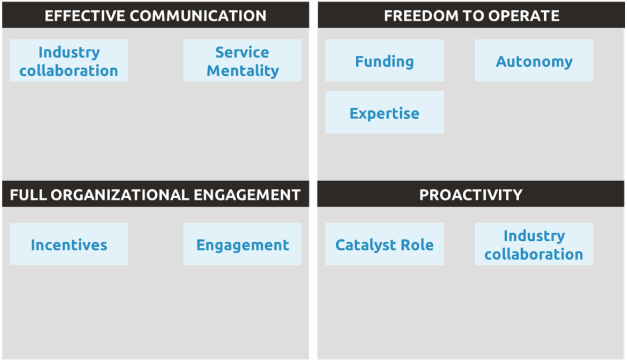In the previous post, we explained the impact of the teacher’s exemption over university’s technology transfer performance. However, in this one, we will explore a bit deeper which are the guidelines to create a successful TTO, according to PROGRESS-TT and one of the most successful technology transfer offices in Europe, the one belonging to the KU Leuven. For this, we will discuss the 8 guidelines exposed from these institutions, adding at the end our point of view and some implementation add-ons.
We can all agree that these measures are a must when creating a TTO. In addition, we think that this all has to do with four main factors:
- Effective communication: first of all, a TTO must be seen as a storefront showing how innovative is the university, so it must have a very strong marketing and communication side. For this, the TTO must have well mapped all their most brilliant researchers, as well as fairs, conferences, and events in their fields of expertise. This way, they can be strong and active in the fields where they are stronger, and therefore known by the industry. Effective communication is also core when transmitting the importance of technology transfer to the very researchers of the university, as the TTO must be seen as a solution-focused office, rather than a bureaucratic burden. For this, both agility and autonomy are key.
- Freedom to operate: this is fully linked with agility and autonomy. The TTO should be in constant contact with industry, and therefore must behave as such, as it must be able to take their own decisions in a fast and pragmatic way. In this point, two crucial points of the guideline must be considered: funding, as a core part of agility comes when the TTO can take their own financial decisions, and expertise to wisely allocate the resources.
- Full organizational engagement: a TTO must be a core department of the university or research facility and must be treated as such. There must not be political biases or barriers to jeopardise its performance. In the end, it must be understood as an extremely specialized sales department and it must be perceived as that from the industry. Organizational engagement is crucial when designing incentive plans for the researchers, as technology transfer must become one of their key performance parameters.
- Proactivity: for us, this is one of the most important factors. A TTO must be in constant contact with the industry and the researchers, organizing talks and courses, open days, generating valuable materials and useful templates to speed up the work for the researchers and be able to bring the innovations in a crisp and clear way to the industry. This proactivity also involves looking for external private and public funding, hiring interim business developers and spin-off/out boosters and starters for their companies, and being proactive looking for potential industry licensees or collaborators.
Nevertheless, this is an ideal, from Viromii we have seen the difficulties TTOs usually have to deal with, being mainly underfunding and lack of specialized staff. Also, a common point between successful TTOs is the number of commercial agents and business development staff they have. We know that this creates a difficult loop to close, as if the TTO’s performance is poor it will not receive enough funding to hire talented and experienced staff, and will hardly improve their deals, but in some occasions the most wise decision would be to disassemble the TTO, take two steps back to see the reasons it was not working, and reassemble it to fill the gaps. That is perhaps not an easy choice, but you can always ask for help!
Sources:

